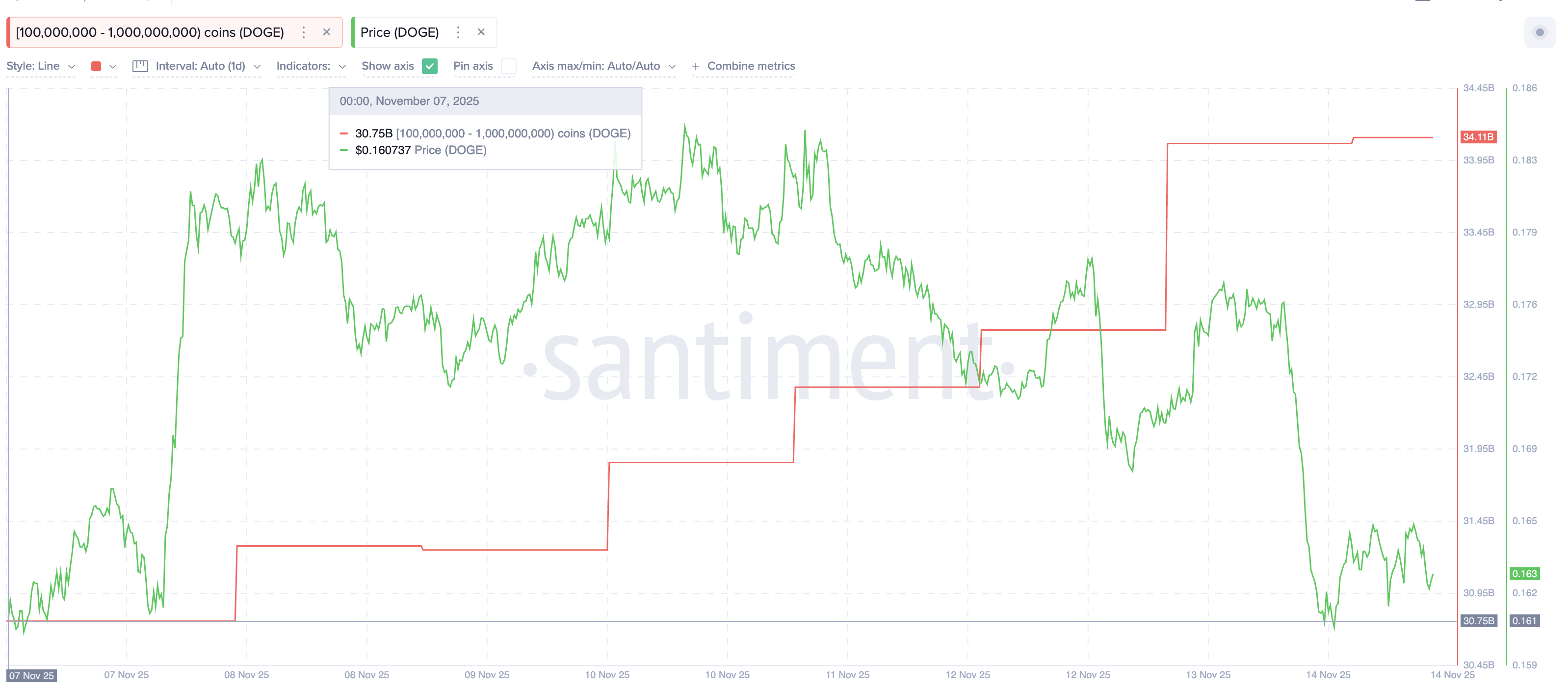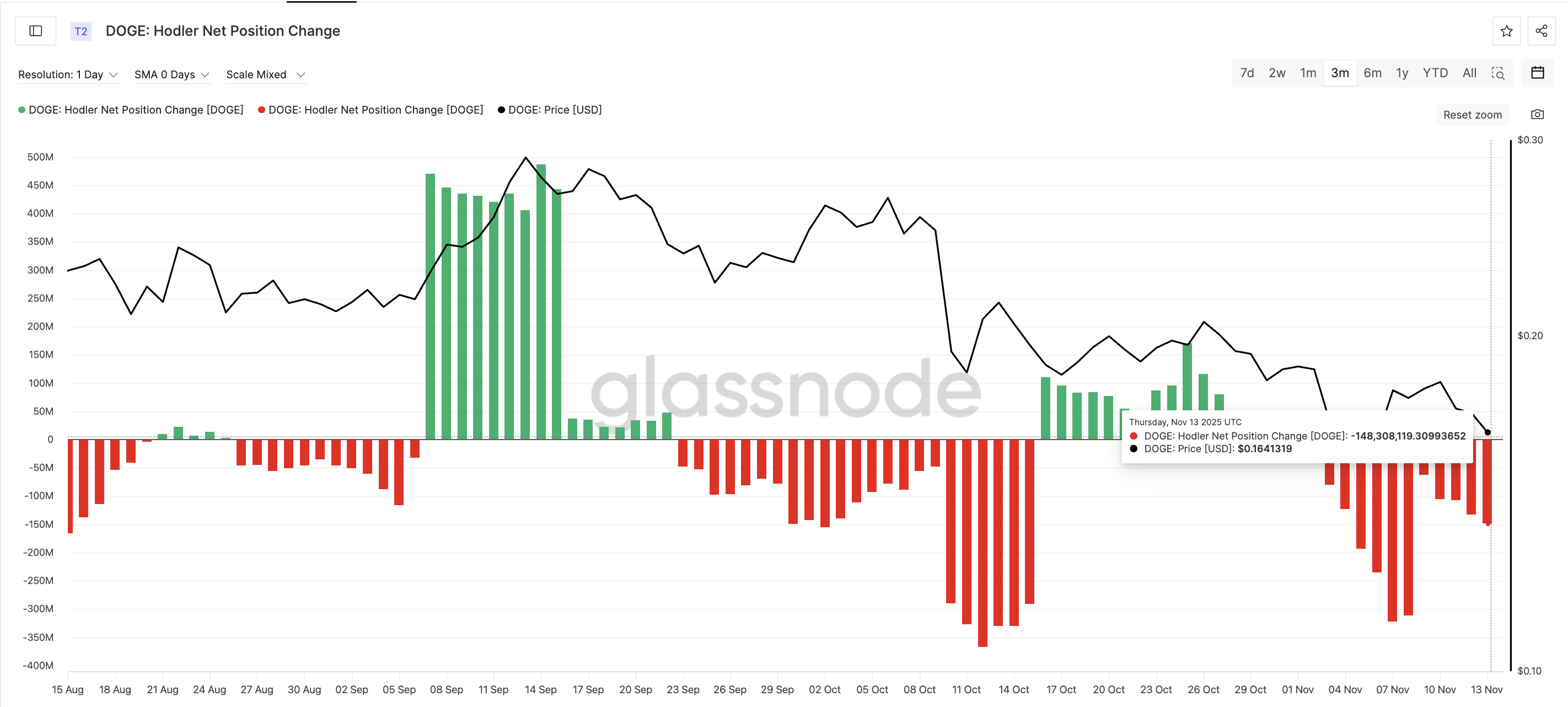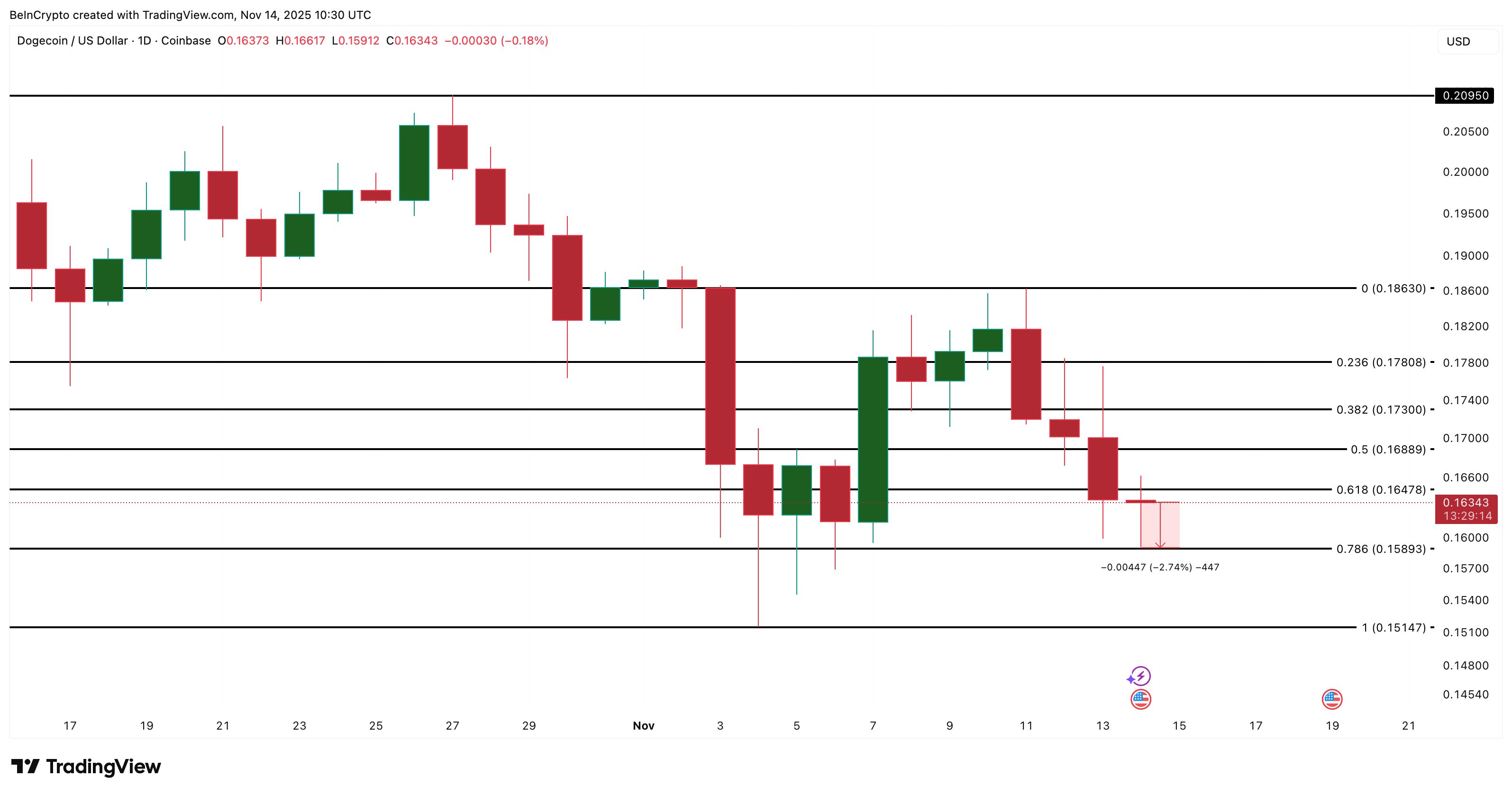Not ETF Buzz, Nor Whales — This Group Can Save Dogecoin (DOGE) Price From a Breakdown
Dogecoin price continues to fall even as whales accumulate and ETF anticipation builds. The only group that has historically triggered DOGE recoveries — long-term holders — is still selling heavily. With the price sitting below a key cost-basis cluster, the next move rests entirely on whether this group flips back to inflows.
Dogecoin is down about 1% over the past week and dropped another 7.3% in the last 24 hours, making it one of the weakest large-cap coins during the latest market dip. The ETF noise did not help either. The countdown for the Bitwise spot Dogecoin ETF began on November 7, but DOGE has barely moved since then.
Whales have been buying too, yet the price keeps sliding. The charts show that one group can stop Dogecoin from breaking down, and they have not returned yet.
Whales Buy and ETF Buzz Builds — But Price Still Drops
Buying from whale wallets holding 100 million to 1 billion DOGE has continued since November 7. On that day, their holdings were 30.75 billion DOGE. Now they hold 34.11 billion DOGE. They added around 3.36 billion DOGE in one week. At today’s price, that represents more than $550 million in accumulated value.
 Dogecoin Whales:
Dogecoin Whales:
Even with this level of buying, DOGE is still down 1% over the same period. The ETF countdown also had no effect. Price stayed flat while institutional interest increased.
Looks like Bitwise is doing the 8(a) move for their spot Dogecoin ETF, which basically means they plan on going effective in 20 days barring an intervention.
— Eric Balchunas (@EricBalchunas) November 6, 2025
When whales buy and the price does not respond, it usually means another force is stronger. That force is long-term holders.
This Hodler Group Has a History of Triggering Rallies and Bounces
The Hodler Net Position Change shows long-term wallets have been selling aggressively. This metric tracks whether long-term holders are adding (inflows) or removing (outflows) coins.
On November 9, long-term holders removed 62.3 million DOGE. As of November 13, that number has jumped to 148.3 million DOGE, leaving long-term wallets. That is a 138% increase in selling pressure in less than a week.
 Dogecoin Hodlers Need To Buy Again:
Dogecoin Hodlers Need To Buy Again:
This same group triggered earlier price reactions:
• Between September 6–7, the metric flipped from outflows to inflows, and DOGE jumped about 33% shortly after.
• Between October 15–16, the same shift produced a smaller bounce of around 5% after a few days.
These moves show a clear pattern: price strength usually returns when long-term holders stop selling and begin adding again. Right now, the signal remains deep in outflows. Until it flips again, DOGE cannot build a real recovery.
Dogecoin Price Nears Breakdown Zone — One Level Holds the Entire Structure
DOGE now trades near $0.163 and sits near its largest cost-basis support cluster. The cost-basis heatmap shows the strongest concentration of holders between $0.164 and $0.165. As long as this zone holds, DOGE can stay stable and attempt a bounce or two.
 Cost Basis Heatmap To Identify Supply Zones:
Cost Basis Heatmap To Identify Supply Zones:
If DOGE closes a daily candle below $0.164 (which is currently possible), it will slip under this cluster. With almost no heavy support levels beneath it, the price can drop quickly. The next key level is $0.158, only 2.6% lower. A breakdown there exposes $0.151 and deeper losses if the market stays weak.
 Dogecoin Price Analysis:
Dogecoin Price Analysis:
On the upside, the DOGE price needs a move above $0.178 to show early strength. A stronger short-term reversal needs a clean break above $0.186. But neither move can hold unless long-term holders return and shift back to inflows.
Disclaimer: The content of this article solely reflects the author's opinion and does not represent the platform in any capacity. This article is not intended to serve as a reference for making investment decisions.
You may also like
Solana's Latest Downturn: Systemic Threats Facing High-Speed Blockchain Platforms
- Solana's $SOL token faces underperformance despite 70M daily transactions and $143B DEX volume, exposing systemic risks in high-throughput blockchain ecosystems. - A $258M whale position liquidation highlights leveraged trading fragility, with cascading losses threatening DeFi protocols and validator staking pools. - Validator reliance on volatile MEV rewards (7% of Figment's delegator income) risks centralization and reward instability amid regulatory uncertainty. - Infrastructure upgrades like UAE vali

As Technology Stocks Plunge Further, the Federal Reserve's Reputation in Handling Crises Is Put to the Test
- U.S. tech stocks face selloff as inflation fears and Fed policy uncertainty drive Nasdaq and S&P 500 declines, with "Magnificent Seven" valuations exceeding 35 P/E ratios. - Apple delays iPhone Air launch due to weak sales, exposing broader consumer demand challenges and compounding market concerns over tech overvaluation. - Monday.com's 20% premarket drop highlights risks as strong Q3 results fail to offset cautious guidance, mirroring sector-wide profit-taking pressures. - Fed's mixed signals on rate c

XRP News Today: XRP’s DeFi Bridge Under Scrutiny: Institutional Investments and Whale Holdings Clash with Market Uncertainty
- XRP surges near $2.50 amid institutional interest and DeFi growth, with $2.55 as a critical liquidity threshold. - mXRP's launch on BNB Chain enables yield generation for XRP holders, leveraging Fireblocks/Fordefi custodial tech. - Whale accumulation boosts XRP's 13.43% controlled supply, contrasting weak retail demand and $245M XRP ETF inflows. - Ripple's $500M funding round and Mastercard/Gemini partnership strengthen XRP's traditional finance integration. - Market volatility persists as broader crypto

Bitcoin Experiences Unexpected Volatility Due to Macroeconomic Changes: Is This a Chance to Buy or a Cautionary Signal for Cryptocurrency Investors?
- Bitcoin's 2025 volatility stems from rate cuts, U.S.-China trade war escalation, and Binance's $20B stablecoin collapse, triggering an 18% sell-off. - Michael Saylor predicts $150,000 by late 2025 via institutional adoption, while structural risks like 84,806 long-term holder sales and Fed policy shifts challenge this outlook. - Leverage-driven ecosystems amplify downturns, with margin calls and liquidations creating self-reinforcing price declines after USDe's de-peg. - Investors face a dilemma: long-te

